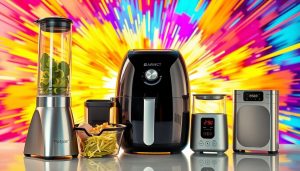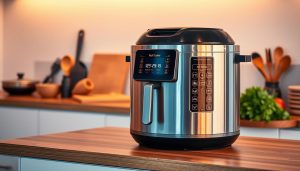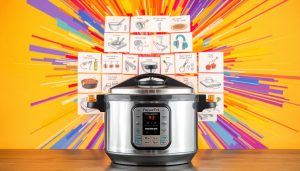Over 13 billion pounds of milk become cheese annually in the U.S. alone – but few realize this transformation starts with a scientific phenomenon hiding in plain sight. That smooth white beverage in your fridge isn’t just a liquid; it’s a delicate colloidal solution where microscopic protein particles float in suspended animation.
When environmental conditions shift, these proteins undergo dramatic changes. A slight drop in acidity levels (pH) acts like a molecular magnet, making formerly independent particles clump together. Warmer temperatures accelerate this natural separation, creating the lumpy texture we recognize as curdled milk.
This process isn’t accidental – it’s essential for creating everyday favorites like ricotta and paneer. Cheesemakers carefully control temperature and acidity to achieve perfect curd formation. Even your morning yogurt relies on controlled protein bonding.
Key Takeaways
- Milk contains suspended proteins that repel each other until acidity changes
- pH levels and temperature directly impact curdling speed and texture
- Controlled separation creates cheese, yogurt, and other dairy staples
- Understanding this process helps prevent unwanted food texture changes
- Protein interactions drive structural transformations in dairy products
Understanding What Causes Curdling in Dairy

Milk’s smooth texture hides a delicate balance of proteins and acids that shift with simple changes. Casein proteins form microscopic spheres called micelles, acting like natural stabilizers. These protein structures repel each other in fresh milk, maintaining its uniform appearance.
Role of Acidity and pH Changes
When acidity rises, the micelle’s protective layer weakens. At pH 4.6 – milk’s tipping point – casein molecules suddenly attract instead of repel. This irreversible shift creates the lumpy texture you see in spoiled dairy or intentional cheese-making.
Enzymatic Reactions and Protein Denaturation
Enzymes like chymosin attack micelle anchors, while proteases slice protein chains. Bromelain from pineapple demonstrates this process, though heat deactivates most enzymes. Warmer temperatures speed up structural changes, explaining why milk curdles faster when heated.
Understanding these reactions helps predict texture changes. Once proteins bond or break apart, they can’t return to their original form. This knowledge proves vital when creating silky sauces or creamy desserts requiring stable dairy solutions.
How to Prevent Milk Curdling in Your Kitchen
Every home cook faces the challenge of maintaining smooth textures when working with dairy. Mastering temperature control and ingredient selection turns potential kitchen disasters into culinary successes.

Proper Heating Techniques for Milk
Use low heat and constant stirring to protect proteins from sudden temperature changes. Keep temperatures below 180°F (82°C) – the danger zone where rapid coagulation begins. A heavy-bottomed saucepan distributes heat evenly, preventing hot spots that trigger unwanted separation.
Using Stabilizing Additives in Recipes
Thickeners like cornstarch create protective barriers around milk proteins. For acidic dishes, a pinch of baking soda balances pH levels. Higher-fat options like heavy cream resist separation better than skim varieties due to their increased lipid content.
| Additive | Function | Example Use |
|---|---|---|
| Cornstarch | Thickens mixture | Cream sauces |
| Baking Soda | Neutralizes acid | Tomato-based soups |
| Heavy Cream | Increases fat content | Hot coffee drinks |
When adding milk to hot liquids, temper it first by mixing with warm liquid gradually. If minor curdling occurs, blend vigorously or strain through cheesecloth. These recovery methods work best with fresh curds that haven’t fully separated.
Conducting a Milk Curdling Experiment
Your kitchen becomes a laboratory when exploring dairy science with common ingredients. This hands-on demonstration reveals how acids and enzymes transform milk’s structure through visible reactions.
Setting Up Your Experiment with Everyday Ingredients
Gather four clear cups, whole milk, fresh lemon juice, pineapple juice, and a saucepan. Label containers 1-4 for tracking:
- Cup 1: 1 tbsp fresh lemon juice + ½ cup milk
- Cup 2: 1 tbsp heated lemon juice + ½ cup milk
- Cup 3: 1 tbsp fresh pineapple juice + ½ cup milk
- Cup 4: 1 tbsp heated pineapple juice + ½ cup milk
Observing the Curd Formation Process
Watch Cup 1 form clumps instantly as citric acid disrupts proteins. Cup 3 shows gradual changes – bromelain enzymes need 5 minutes to break down casein. Heated solutions (Cups 2 & 4) demonstrate how temperature affects curdling agents differently.
Analyzing Results and Understanding Variations
Compare curd textures and separation speeds. Lemon-induced curds appear chunky, while pineapple creates finer particles. The table below summarizes key observations:
| Treatment | Curdling Time | Active Component |
|---|---|---|
| Fresh Lemon | Immediate | Citric Acid |
| Heated Lemon | No curdling | Denatured Acids |
| Fresh Pineapple | 5 minutes | Bromelain Enzyme |
| Heated Pineapple | No curdling | Destroyed Enzymes |
Record how milk fat content or juice concentration alters results. Skim milk produces weaker curds, while higher-acid solutions speed separation. This experiment clarifies why some recipes fail and others succeed with dairy.
Conclusion
From kitchen mishaps to artisanal cheeses, protein behavior shapes dairy’s destiny. The process of controlled coagulation transforms liquid milk into diverse foods through precise chemical reactions. Whether adjusting acidity levels or introducing enzymes, these changes create textures ranging from creamy yogurt to firm cheese blocks.
Your kitchen experiments reveal how heat and pH alter milk’s structure irreversibly. Acid-induced clumps form cottage cheese, while enzyme-driven reactions craft aged varieties like cheddar. Stabilizing techniques prevent unwanted separation in sauces, showing science’s dual role in food preparation.
This knowledge transforms how you view everyday ingredients. Milk becomes more than a beverage – it’s raw material for culinary innovation. By mastering protein interactions, you control outcomes whether preventing sour coffee additions or crafting homemade ricotta. Every reaction tells a story of chemistry shaping flavor and texture.



